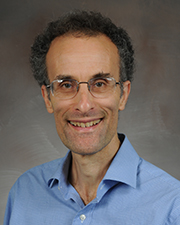
William Margolin, Ph.D.
- 教授
Biography
Dr. Margolin grew up in Tenafly, NJ, near New York City. He attended M.I.T. as an undergraduate, where he worked on E. coli genetics research with Graham Walker, and biochemical engineering research on thermophilic clostridia with Daniel I.C. Wang. He then completed his Ph.D. work on transcriptional regulation in bacteriophage Mu with Martha Howe at the University of Wisconsin-Madison. Dr. Margolin followed this with an NSF postdoctoral fellowship in Plant Biology with Sharon Long at Stanford, where he studied the role of FtsZ in cell division of rhizobia.
He joined the Department of Microbiology and Molecular Genetics at UTHealth Houston’s McGovern Medical School in 1993 to begin his long-standing investigation of bacterial cell division and organization.
Education
- Postdoctoral Fellow
- Stanford University
- Ph.D.
- University of Wisconsin, 1989
Research Information
Targeting and assembly of the bacterial cell division complex
Cell division, or cytokinesis, is a fundamental requirement for the proliferation of all cells. Cytokinesis is regulated temporally and spatially to insure that daughter cells contain the normal complement of chromosomes. We study the regulation of cell division in bacteria, which enables us to use highly sophisticated genetic approaches. Despite our vast knowledge of prokaryotic biology, we still understand surprisingly little about how bacteria, such asEscherichia coli, divide by binary fission.
One of the cell division proteins we focus on is FtsZ. FtsZ is an abundant protein that, in response to an unknown signal, polymerizes into a ring structure marking the division site and is essential for the initiation of cell division. Other essential proteins, such as FtsA and FtsK, are then recruited to the FtsZ ring and act in a putative complex to complete division. FtsZ is ubiquitous, with homologs in eubacteria, archaea and chloroplasts. Current evidence suggests that FtsZ is essential to define the cell division plane in all non-nucleated cells. What has made working on these protein even more exciting is that FtsZ and FtsA are homologs of the eukaryotic cytoskeletal proteins tubulin and actin, respectively. In the last few years we have focused particularly on FtsA, as it seems to be a key regulator of the FtsZ ring.
Our long-term goals are to understand how FtsZ and other cell cycle proteins target precisely to the division site, do so only once per cell division cycle, and achieve the constrictive force necessary for cytokinesis. We are also interested in the diversity of cell division mechanisms among microorganisms.
Publications
Publication Information
Krupka, M., Sobrinos-Sanguino, M., Jimenez, M., Rivas, G., andMargolin, W. (2018)Escherichia coliZipA organizes FtsZ polymers into dynamic ring-like protofilament structures. mBio, in press.
织女星,d和Margolin, W. (2018) Suppression of a thermosensitivezipAcell division mutant by altering amino acid metabolism. J. Bacteriol., 200: e00535-17.
林,Y., Bogdanov., M., Lu, S., Guan, Z.,Margolin, W维斯,J。,郑,l(2018)磷脂再保险pair system LplT/Aas protects the Gram-negative bacterial membrane envelope from host phospholipase A2attack. J. Biol. Chem., 293:3386-3398.
Fan, Y., Evans, C.R., Barber, K., Banerjee, K., Weiss, K.J.,Margolin, W., Igoshin, O., Rinehart, J., and Ling, J. (2017) Heterogeneity of stop codon readthrough in single bacterial cells and implications for population fitness. Mol. Cell 67:826-836.
Krupka, M., Rowlett, V.W., Morado, D., Vitrac, H., Schoenemann, K., Liu, J., andMargolin, W. (2017)Escherichia coliFtsA forms lipid-bound minirings that antagonize lateral interactions between FtsZ protofilaments, Nat. Commun. 11:15957.
Rowlett, V., Mallampalli, V.K., Karlstaedt, A., Taegtmeyer, H., Dowhan, W.,Margolin, W., and Vitrac, H. (2017) The impact of membrane phospholipid alterations inEscherichia colion cellular function and bacterial stress adaptation. J. Bacteriol. 199: e00849-16.
Dang, H.Q., Zhou, Q., Rowlett, V.W., Hu, H., Lee, K.J.,Margolin, W., and Li, Z. (2017) Proximity interactions among basal body components inTrypanosoma bruceiidentify novel regulators of basal body duplication and separation. mBio 8:e02120-16.